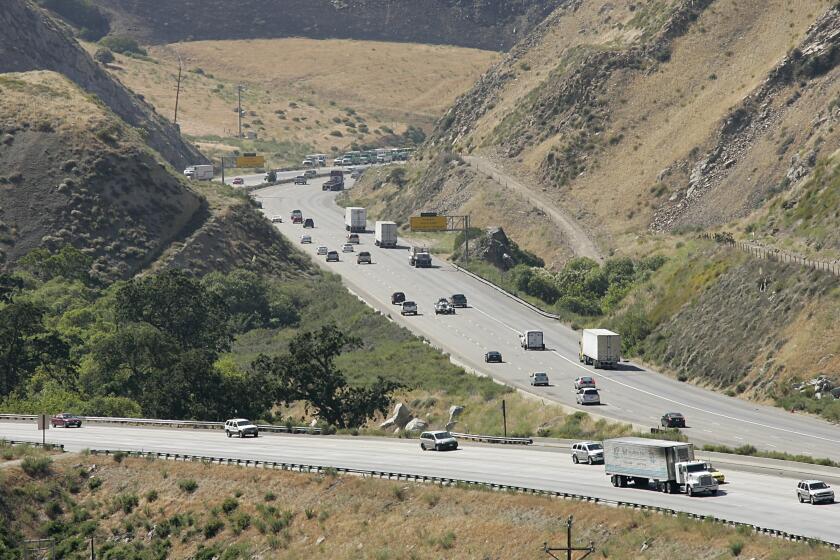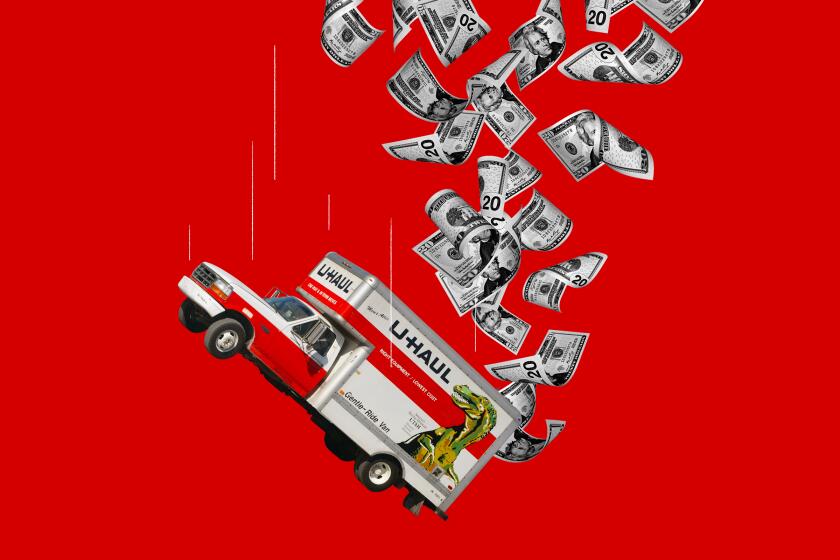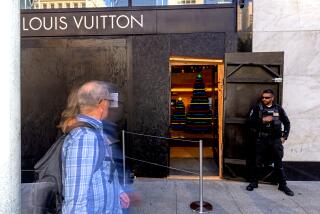Brink’s driver was asleep inside vehicle during multimillion-dollar jewelry heist
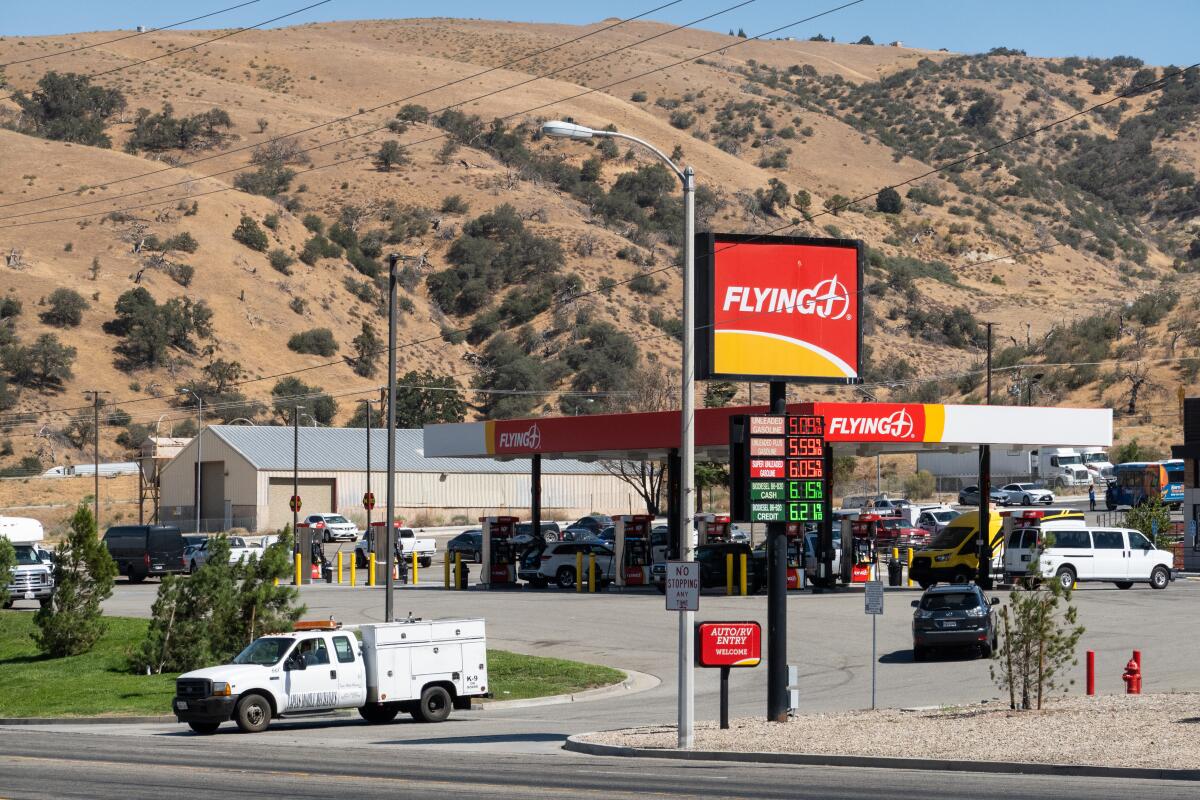
- Share via
When thieves broke into a Brink’s tractor-trailer and stole millions of dollars of jewelry in a late-night heist at an Interstate 5 truck stop last month, one of the drivers was asleep in the vehicle’s sleeping berth, the company says.
That revelation was disclosed in a lawsuit filed by Brink’s against 13 jewelers whose wares the company was transporting from San Mateo to the L.A. area for the International Gem and Jewelry Show.
Brink’s alleged that the driver “did not see or hear anything unusual” during a 27-minute period in which the trailer’s plastic seal was removed and its rear lock “cut away.” At the time, the big rig’s other armed driver was inside the truck stop getting food, the company alleged. In all, 22 large bags of gems, gold and other valuables were taken in the July 11 incident at the Flying J Travel Center in Lebec.
Law enforcement officials have provided scant details about their investigation of what has become known as the Flying J heist, which has riveted the sparsely populated Grapevine area where the truck stop is located. However, Los Angeles County Sheriff’s Department investigators — who are working with the FBI — say they have obtained video footage related to the incident.
“You cannot move 100 feet without being captured on video,” said Sgt. Michael Mileski of the sheriff’s Major Crimes Bureau, who declined to disclose details of the footage. He confirmed that one of the tractor-trailer’s drivers was asleep inside the vehicle when the crime was committed, attributing the information to the Brink’s drivers.
It took just 27 minutes to steal tens of millions in jewelry and gemstones from a Brink’s trailer in Lebec, Calif.
The FBI shared with The Times several photographs of the stolen items, among them large, loose gemstones and dozens of jewel-encrusted rings set in display cases. A spokeswoman for the agency said the images showed “a sampling of the stolen items.”
The loss of the valuable merchandise has devastated the jewelers, according to a legal filing. And the owners of one of the businesses, Lam’s Jade Center in L.A., wrote in a letter to Brink’s that their “whole life savings has been totally wiped out.”
“No merchandise, no business, no money coming in, we are in a terrible situation,” wrote Leona and Paul Wong. The letter was provided to The Times by the proprietors’ attorney, who said it has been sent to Brink’s. “We are losing our customers, goodwill and credibility to our creditors. These last few weeks have been the worst time of our lives.”
They and other jewelers filed a lawsuit Monday against Brink’s and additional parties that questioned the company’s efforts to protect their precious cargo. The jewelry companies — which are seeking at least $100 million in restitution and at least $100 million in damages — alleged that the tractor-trailer was unarmored and parked in a “poorly lit” location at the Flying J. It was, the complaint said, positioned out of the “immediate vicinity” of security cameras, with its trailer’s back door facing away from the building where one of the drivers was getting food.
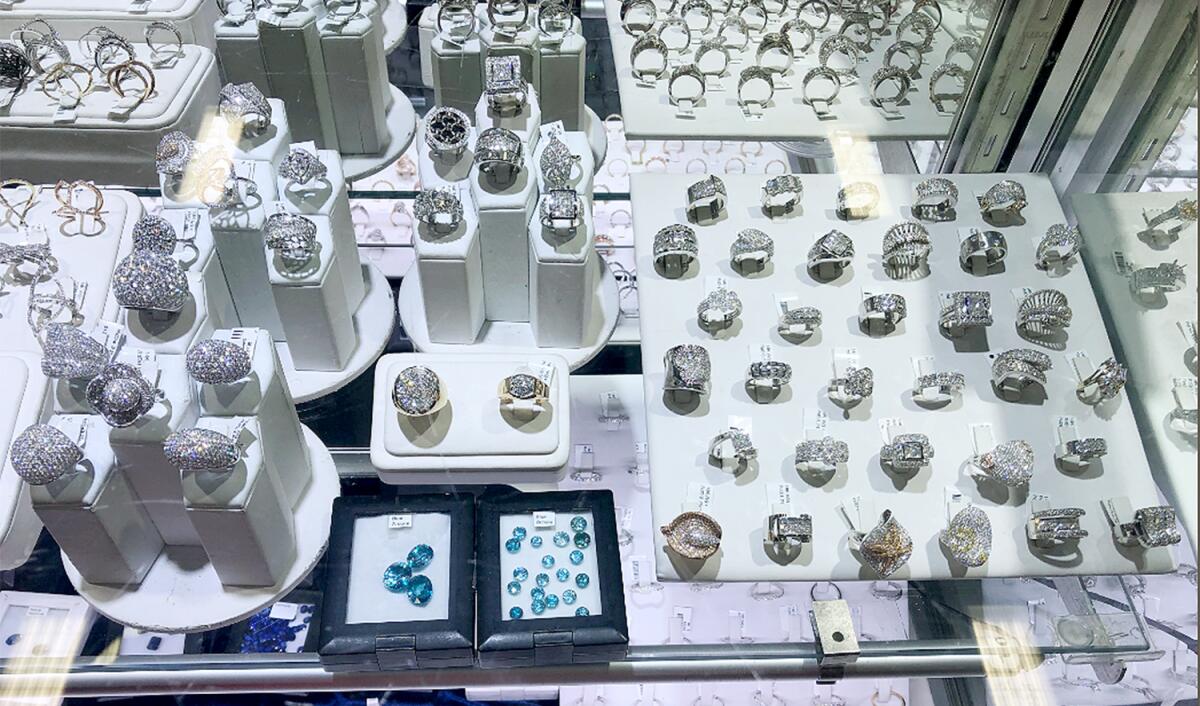
The total value of the plunder is contested — and the subject of the dueling lawsuits as Brink’s and the jewelers feud over how much they should be paid. Estimates range from Brink’s claim that the merchandise was valued at less than $10 million to roughly 10 times that amount. A valuation at the higher end — the jewelers alleged in their lawsuit that the goods were worth about $100 million — would make the theft one of the biggest in modern history. The Aug. 4 lawsuit filed by Brink’s seeks to limit any payout it could have to make to the jewelry businesses, eight of which are based in L.A.
Brink’s asked a New York court to declare that the Richmond, Va., company’s responsibilities to the 13 jewelers are governed by their contracts with the security and logistics behemoth. The lawsuit includes language from a Brink’s contract that indicates the company will pay clients for items lost during shipping — up to their declared value.
The higher a shipment’s declared value, the more expensive it is to ship, owing to increased insurance costs. Arnold Duke, president of the International Gem and Jewelry Show, said that, in general, jewelers can “reduce their costs tremendously” by assigning their merchandise lower values than their fair-market cost.
Brink’s alleged that the stolen shipments have a declared total value of $8.7 million — a figure it said was drawn from manifests signed by its jeweler customers ahead of the tractor-trailer’s departure from the San Mateo County Event Center. Citing media reports that said the missing shipments were worth more than $100 million, Brink’s alleged that the 13 jewelry companies “substantially under-declared the value of their shipments” when they consented to having their wares ferried by the company to a trade show in Pasadena.
“Brink’s believes that each Defendant seeks to recover more from Brink’s than is permitted under the Contract,” said the company, which also asked the court to consider finding that it is not liable for the losses of defendants who did not accurately describe the monetary value of their property.
The 13 jewelers have not responded to Brink’s lawsuit, according to online legal records.
Billionaire Phil Anschutz — who owns the Coachella music festival, the Los Angeles Kings hockey team and L.A.’s Crypto.com Arena — is preparing to build the nation’s largest wind farm. We traveled the route.
Duke previously told The Times that “we are looking at more than $100 million in documented losses. ...We are talking gold, diamonds, rubies, emeralds and loads of luxury watches.”
In their letter to Brink’s, the Wongs said that they have long relied on the company to transport merchandise during their 46 years as jewelers, and it “became a habit to declare” the value of their goods as $400,000. “This amount does not represent the fair-market value of the goods since we never expected that it would be robbed,” the Wongs wrote. They said that the “fair-market value” of their stolen items is about $1.14 million.
The Times sought interviews with each of the 13 jewelry companies; some did not return calls seeking comment, and others referred the matter to their legal counsel. But the jewelers’ lawsuit alleged the “mom-and-pop” operators are suffering from “extreme stress, anxiety, embarrassment, humiliation” and other issues. Jewelry trade shows were the only income source for many of the jewelers, their lawsuit said, and the “loss of their inventory prevents them from earning any income, imposing substantial financial distress.”
Their attorney, Gerald L. Kroll, said he’s on the phone with his clients most nights until 2 a.m. “All of them are distraught, stressed and wondering what they are going to do next,” he said. “Some of my clients have told me they don’t know how they are going to put food on the table. They are in their 60s, 70s. This is trauma. And every day, the reality of it sinks in more and more.”
The jewelers’ lawsuit alleged breach of contract, negligence and other claims. The complaint listed 14 jewelry businesses as plaintiffs, including one that was not sued by Brink’s.
The lawsuit said that agreements signed by the jewelers contained illegible contract text in verso and therefore “cannot be binding.” It also alleged that a representative of Brink’s who attended the San Mateo jewelry show advised multiple jewelers to “understate their value on the Pickup Manifests in order to save money, because the cost of shipping would be too expensive if they declared the full value of their goods.”
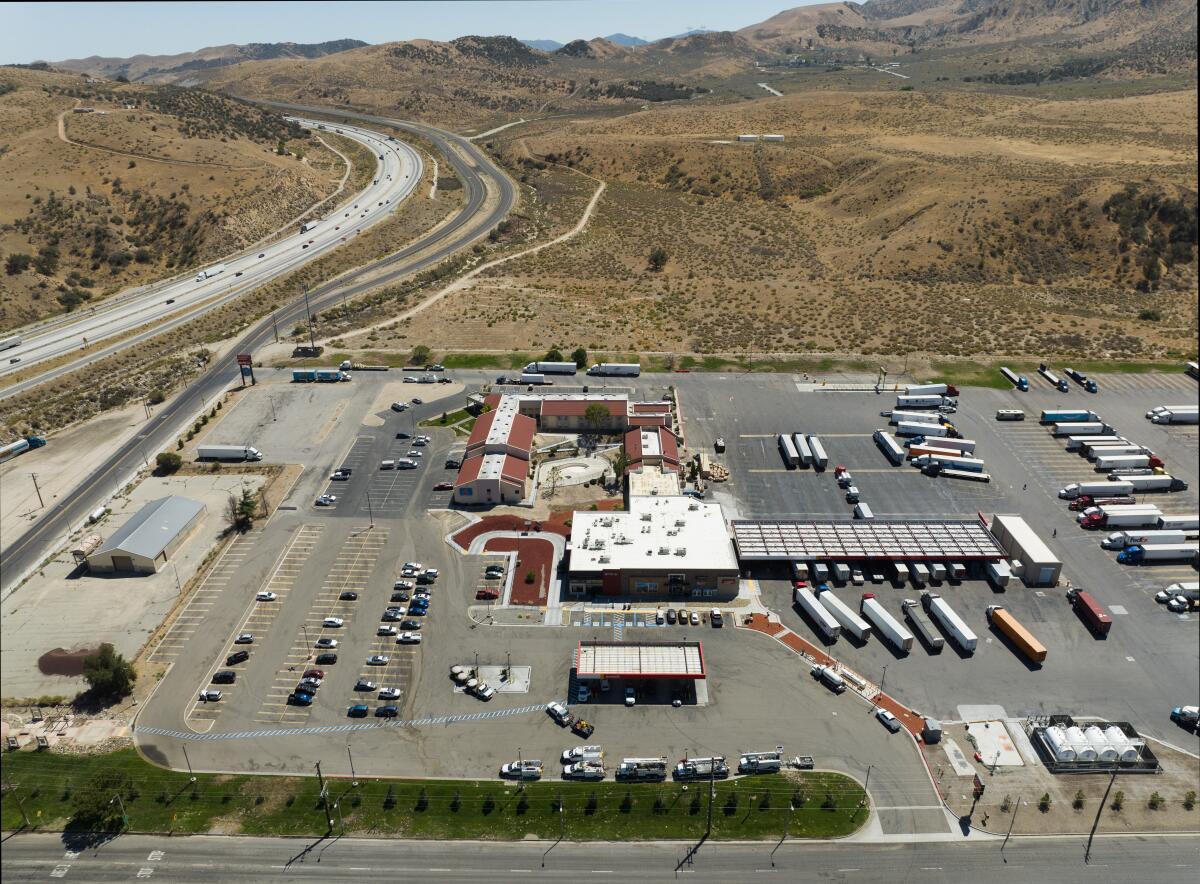
The Brink’s employee, who is named as a defendant in the lawsuit, “did not warn Plaintiffs that understating the value would preclude them from recovery or limit the amount of their recovery in the event of loss,” the lawsuit alleged.
The Times could not reach the employee for comment.
The jewelers’ lawsuit also alleged that the tractor-trailer drivers’ conduct was “grossly negligent.” It claimed that “lax security” by Brink’s allowed “jewelry and gemstones to be stolen right out from under the noses” of the drivers, both of whom are listed as defendants in the complaint, along with Pilot Corp., the operator of the Flying J.
Pilot did not respond to a request for comment and Brink’s declined to comment, citing the active litigation. The company previously released a statement that said in part that it would “fully reimburse our customers for the value of their assets that were stolen, in accordance with the terms of our contract.”
In 1997, five men in downtown L.A. stole $18.9 million in under 30 minutes. Here is the story behind the Dunbar Armored Co. depot heist.
The Brink’s lawsuit, which was filed in U.S. District Court for the Southern District of New York, offered a sparse account of the Flying J episode. It alleged that on the evening of July 10, an armored Brink’s big rig was loaded with 73 bags of jewelry and other items at the San Mateo jewelry show. At midnight, the tractor-trailer departed for a Brink’s storage yard about 370 miles south in Los Angeles, the complaint said. On board were two drivers — the lawsuit identified them only as Driver 1 and Driver 2.
Upon departure, Driver 2 went to sleep inside the vehicle’s sleeping berth, in accordance with Department of Transportation regulations, the lawsuit alleged. At about 1:49 a.m., Driver 1 stopped the vehicle at the Buttonwillow rest area along Interstate 5 to use the restroom, the complaint said. Then, at 2:05 a.m., he pulled over again — this time at the Flying J, it said.
(The chronology described in the Brink’s lawsuit suggests an improbably swift journey for the tractor-trailer. For example, Buttonwillow is roughly 55 miles from the Flying J in Lebec — a distance the lawsuit alleged the big rig covered in about 16 minutes.)
At the Flying J, Driver 1 left the vehicle to get food at the truck stop but did not wake up Driver 2, the lawsuit alleged, noting that this course of action complied with Department of Transportation regulations.
Per Department of Transportation rules, commercial truck drivers can be on duty for 14 hours of a 24-hour period. When they enter a vehicle’s sleeper berth, time spent there cannot be interrupted if it is to count toward the 10 hours of required off-duty time per day. Dan Horvath, vice president of safety policy at the American Trucking Assns., said that this policy could explain why Driver 1 did not wake up Driver 2.
“If it’s a matter of somebody getting their rest so that they are compliant with the DOT regulations, and so that they aren’t fatigued, drivers are going to do their best to not disturb a driver that is in the sleeper berth,” Horvath said.
When Driver 1 returned to the big rig at 2:32 a.m., he saw the trailer’s red plastic seal lying on the ground and found that the vehicle’s rear lock had been cut, the lawsuit alleged. Driver 1 spoke to his partner, who said that nothing unusual had occurred. They called law enforcement, which soon arrived and found that 22 bags were missing.
On an Aug. 3 call with analysts to discuss Brink’s second-quarter earnings, Chief Executive Mark Eubanks fielded an analyst’s question about the Flying J heist, and insisted that “the loss would be less than $10 million at the worst case” — an amount he said was “contrary to some fairly salacious media reports out there.”
“Our guidance on an ongoing basis routinely includes estimates for losses. This is part of our business. We use historical data to do that,” Eubanks said. “The impact on this loss should not be material to our results.”
More to Read
Inside the business of entertainment
The Wide Shot brings you news, analysis and insights on everything from streaming wars to production — and what it all means for the future.
You may occasionally receive promotional content from the Los Angeles Times.
